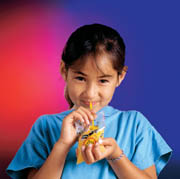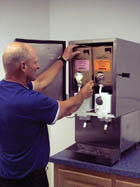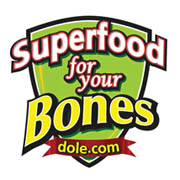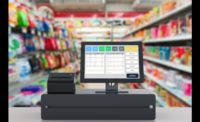
The pouch, made from polyethylene film, fits neatly into a child's hand. It was developed by Liqui-Box Corp. in the 1990s, with management moving to DuPont Canada after Liqui-Box was acquired in 2002. Designed with school lunch programs in mind, the pouch has done well in Latin America and states with restrictive landfill policies, including Florida and Louisiana. Pitched by DuPont as "better for the environment," the pouch also has been successful in California, less so in Hummer-buying states. The toughest sell, however, is to some early Earth Day participants: the people who run the nation's schools.
"Adults are the obstacle," notes Rocky Lovelace, sales manager at Tampa-based M&B Products Inc., a beverage company that first filled the pouches with milk a dozen years ago, then extended them to juice and, last year, water. "People have to have environmental reasons and be motivated to reduce trash costs. It is not an easy sale."
School administrators are the package's biggest skeptics, says Susan Herring, foodservice director for the 53,000-student Cumberland County Schools, North Carolina's fourth largest school district. A four-year milk-in-a-pouch program expanded to include water last year, though not without resistance from the top. A California trainer was brought in to instruct children how to lance the pouch with a straw, a skill they mastered in their preschool years. As program champion, Herring ultimately prevailed: "I'm the one who pays the trash-removal bill, and I don't want to take any more trash to the landfill than I absolutely have to," she says.
DuPont supplies a customized filler for the pouches, and pricing is volume dependent. At the low end, the pouches cost at least 4 cents a unit less than HDPE single-serve bottles, claims Laura Coomey, DuPont's US sales manager of Mini-Sip. But milk marketing boards are pushing dairies toward HDPE with studies that contrast sales in plastic bottles with cartons while ignoring other alternatives. M&B's Lovelace agrees, saying, "Dairies are fewer and farther between, and they just want the most popular seller: the carton and now the plastic bottle."
In Cumberland County, a test of milk in HDPE was aborted when sales lagged. Cafeteria coolers since have been removed. Refrigeration efficiency is better with the pouch, Herring points out. "The milk is colder than it ever was in a carton or bottle because there's more direct contact with cold air," she says. The space-saving structure also eases transport during field trips and other off-premise events.
But benefits like a 70 percent reduction in trash volume won't resonate until commissaries must deal with sharply higher trash costs. It took $3 a gallon gas to end America's love affair with the SUV; economic penalties for waste likely will drive efficient alternatives in foodservice beverage packaging.
For more information:
Laura Coomey,
DuPont Liqui-Box Canada Inc.,
905-666-7185,
laura.coomey@can.dupont.com
Want milk? Just concentrate
Function trumps form in foodservice packaging, and one of the more innovative functional packages for milk is entering distribution with a push from a Boise, ID, firm.The Good Cow Co. launched its milk dispensing system last summer after gaining approval from the US Army Soldier Systems Center in Natick, MA. The chocolate and white milk dispensers' stainless-steel exterior doesn't look much different than a conventional unit, and the fluid squirting into a glass appears typical. The real differences are more than skin deep: inside the compartment are two 2.5-gallon bag-in-boxes of concentrated milk, enough to generate six gallons each of fluid product when combined with water treated by reverse osmosis. Moreover, trace-back to the farm where the cow was milked is provided, adding a level of quality assurance unattainable in conventional dairy processing

Naval ships and other constrained-space commissaries are a logical opportunity for concentrated milk, though Corby believes the market is much larger. "Foodservice operators always hire people who weigh 90 lbs. to lug around 55-lb. milk containers," she wryly notes. Hoisting and handling concentrated milk is considerably easier.
Unable to source a dispenser with the reliability and precise mixing the system required, Good Cow commissioned a unit that would. "We had to design for the Marines," she says. "It's a little beefy, but compared to what is out there, it's very slick."
Another challenge has been finding an easy-to-install aseptic pouch. Single-fitment pouches offer an innovative solution, "if we can get the (filler) packaging people off the dime," says Corby. Aseptic distribution also will expand Good Cow's potential, and she expects to offer aseptic concentrate by year's end.
A bigger challenge may be "people's intimidation about technology," she believes. "The reaction is, ‘What do you mean, you took water out?'" If innovation can trump resistance to change, Good Cow could reshape a beverage segment.
For more information:
Trish Corby,
Good Cow Co.,
208-884-4299
Bananas as billboards
The difference between a commodity item and a value-added product can be as simple as the package-or, in the case of Dole Food Co.'s Superfoods initiative, a sticker.Logos identifying certain fruits and vegetables as particularly good nutritional sources for joints, eyes and other body parts began appearing on select Dole items in produce and frozen-food sections of supermarkets in September. Not all Dole products sport the Superfoods sticker: nutritional research must confirm an item is dense with a particular vitamin or enzyme before the logo is affixed. "We didn't start out with a list of what we sell but with a list of foods that are scientifically recognized as having a particular health benefit," explains Jennifer Grossman, director of the Dole Nutrition Center, where the Superfoods program was developed.

The labeling program is the brainchild of Dole Chairman David Murdock. Murdock backed a National Cancer Institute-FDA initiative in 2003 in which stickers were affixed to Dole bananas. The stickers read, "Diets rich in fruits and vegetables may reduce the risk of some types of cancers and other chronic diseases."
"That was a pretty wordy statement," Grossman allows, but it helped Dole overcome technical issues in adhering a removable label to a piece of raw fruit.
For more information:
Jennifer Grossman,
Dole Nutrition Center,
818-874-4938



